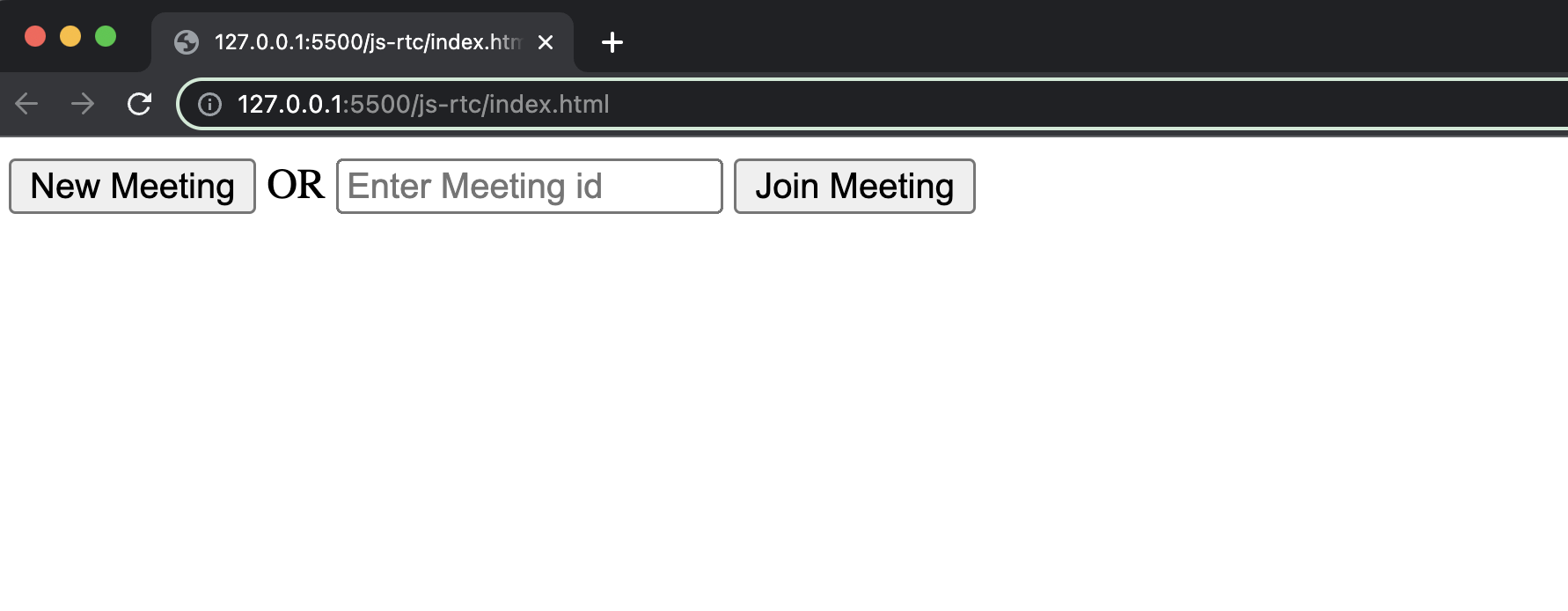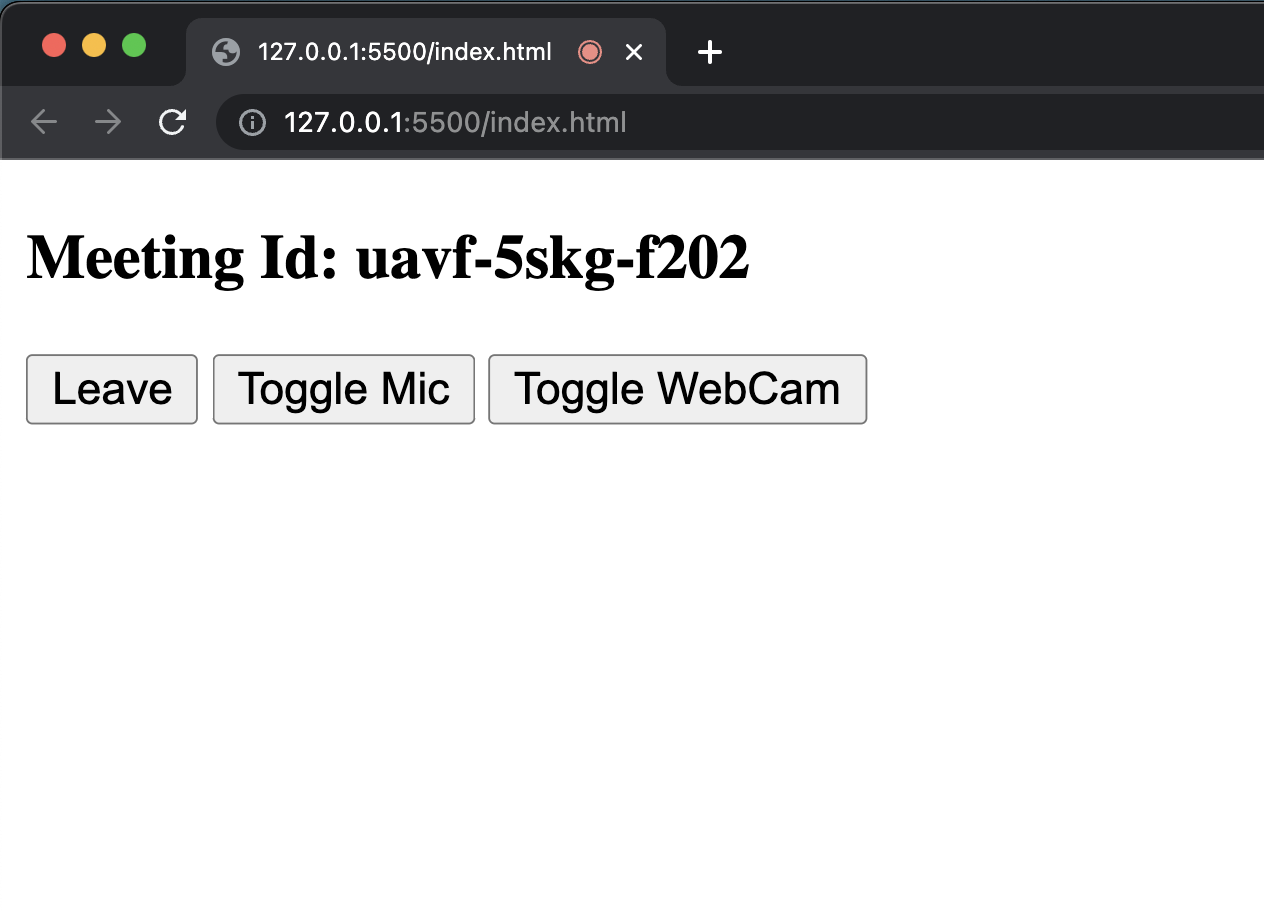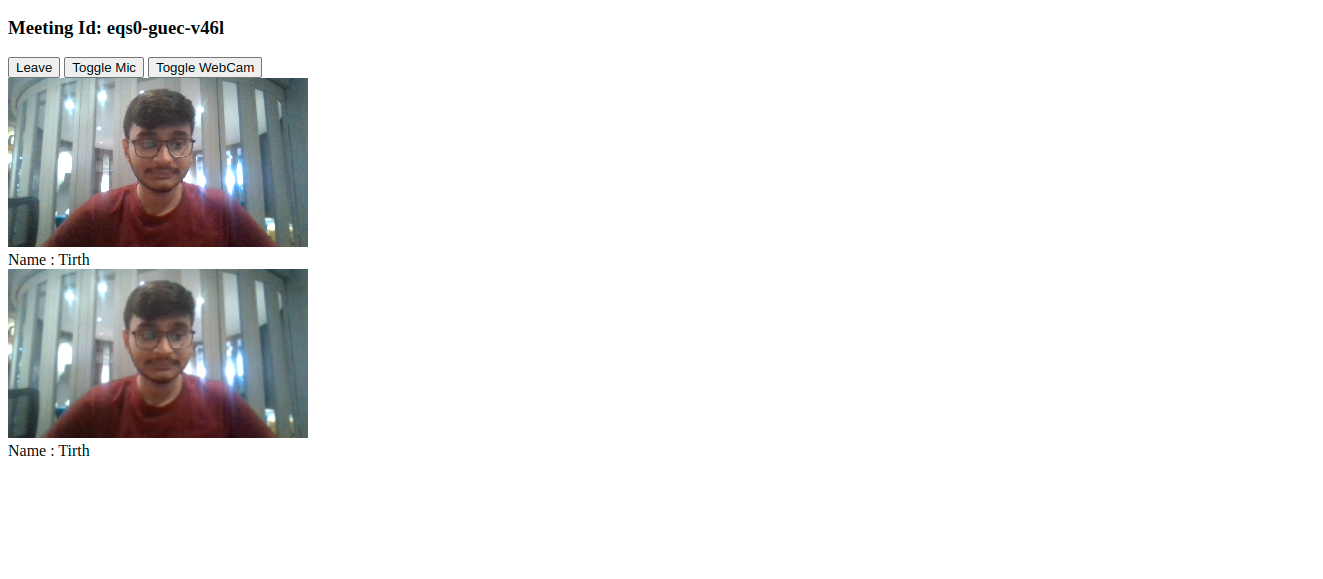Quick Start for Conference in Javascript
VideoSDK empowers you to seamlessly integrate the video calling feature into your Javascript application within minutes.
In this quickstart, you'll explore the group calling feature of VideoSDK. Follow the step-by-step guide to integrate it within your application.
Prerequisites
Before proceeding, ensure that your development environment meets the following requirements:
- Video SDK Developer Account (Not having one, follow Video SDK Dashboard)
- Have Node and NPM installed on your device.
One should have a VideoSDK account to generate token. Visit VideoSDK dashboard to generate token
Getting Started with the Code!
Follow the steps to create the environment necessary to add video calls into your app. You can also find the code sample for quickstart here.
First create one empty project using mkdir folder_name on your preferable location.
Install Video SDK
Import VideoSDK using the <script> tag or Install it using the following npm command. Make sure you are in your app directory before you run this command.
- <script>
- npm
- yarn
<html>
<head>
<!--.....-->
</head>
<body>
<!--.....-->
<script src="https://sdk.videosdk.live/js-sdk/0.1.6/videosdk.js"></script>
</body>
</html>
npm install @videosdk.live/js-sdk
yarn add @videosdk.live/js-sdk
Structure of the project
Your project structure should look like this.
root
├── index.html
├── config.js
├── index.js
You will be working on the following files:
- index.html: Responsible for creating a basic UI.
- config.js: Responsible for storing the token.
- index.js: Responsible for rendering the meeting view and the join meeting functionality.
Step 1: Design the user interface (UI)
Create an HTML file containing the screens, join-screen and grid-screen.
<!DOCTYPE html>
<html>
<head> </head>
<body>
<div id="join-screen">
<!-- Create new Meeting Button -->
<button id="createMeetingBtn">New Meeting</button>
OR
<!-- Join existing Meeting -->
<input type="text" id="meetingIdTxt" placeholder="Enter Meeting id" />
<button id="joinBtn">Join Meeting</button>
</div>
<!-- for Managing meeting status -->
<div id="textDiv"></div>
<div id="grid-screen" style="display: none">
<!-- To Display MeetingId -->
<h3 id="meetingIdHeading"></h3>
<!-- Controllers -->
<button id="leaveBtn">Leave</button>
<button id="toggleMicBtn">Toggle Mic</button>
<button id="toggleWebCamBtn">Toggle WebCam</button>
<!-- render Video -->
<div class="row" id="videoContainer"></div>
</div>
<!-- Add VideoSDK script -->
<script src="https://sdk.videosdk.live/js-sdk/0.1.6/videosdk.js"></script>
<script src="config.js"></script>
<script src="index.js"></script>
</body>
</html>
Output

Step 2: Implement Join Screen
Configure the token in the config.js file, which you can obtain from the VideoSDK Dashbord.
// Auth token will be used to generate a meeting and connect to it
TOKEN = "Your_Token_Here";
Next, retrieve all the elements from the DOM and declare the following variables in the index.js file. Then, add an event listener to the join and create meeting buttons.
// Getting Elements from DOM
const joinButton = document.getElementById("joinBtn");
const leaveButton = document.getElementById("leaveBtn");
const toggleMicButton = document.getElementById("toggleMicBtn");
const toggleWebCamButton = document.getElementById("toggleWebCamBtn");
const createButton = document.getElementById("createMeetingBtn");
const videoContainer = document.getElementById("videoContainer");
const textDiv = document.getElementById("textDiv");
// Declare Variables
let meeting = null;
let meetingId = "";
let isMicOn = false;
let isWebCamOn = false;
function initializeMeeting() {}
function createLocalParticipant() {}
function createVideoElement() {}
function createAudioElement() {}
function setTrack() {}
// Join Meeting Button Event Listener
joinButton.addEventListener("click", async () => {
document.getElementById("join-screen").style.display = "none";
textDiv.textContent = "Joining the meeting...";
roomId = document.getElementById("meetingIdTxt").value;
meetingId = roomId;
initializeMeeting();
});
// Create Meeting Button Event Listener
createButton.addEventListener("click", async () => {
document.getElementById("join-screen").style.display = "none";
textDiv.textContent = "Please wait, we are joining the meeting";
// API call to create meeting
const url = `https://api.videosdk.live/v2/rooms`;
const options = {
method: "POST",
headers: { Authorization: TOKEN, "Content-Type": "application/json" },
};
const { roomId } = await fetch(url, options)
.then((response) => response.json())
.catch((error) => alert("error", error));
meetingId = roomId;
initializeMeeting();
});
Step 3: Initialize meeting
Following that, initialize the meeting using the initMeeting() function and proceed to join the meeting.
// Initialize meeting
function initializeMeeting() {
window.VideoSDK.config(TOKEN);
meeting = window.VideoSDK.initMeeting({
meetingId: meetingId, // required
name: "Thomas Edison", // required
micEnabled: true, // optional, default: true
webcamEnabled: true, // optional, default: true
});
meeting.join();
// Creating local participant
createLocalParticipant();
// Setting local participant stream
meeting.localParticipant.on("stream-enabled", (stream) => {
setTrack(stream, null, meeting.localParticipant, true);
});
// meeting joined event
meeting.on("meeting-joined", () => {
textDiv.style.display = "none";
document.getElementById("grid-screen").style.display = "block";
document.getElementById(
"meetingIdHeading"
).textContent = `Meeting Id: ${meetingId}`;
});
// meeting left event
meeting.on("meeting-left", () => {
videoContainer.innerHTML = "";
});
// Remote participants Event
// participant joined
meeting.on("participant-joined", (participant) => {
// ...
});
// participant left
meeting.on("participant-left", (participant) => {
// ...
});
}
Output

Step 4: Create the Media Elements
In this step, Create a function to generate audio and video elements for displaying both local and remote participants. Set the corresponding media track based on whether it's a video or audio stream.
// creating video element
function createVideoElement(pId, name) {
let videoFrame = document.createElement("div");
videoFrame.setAttribute("id", `f-${pId}`);
//create video
let videoElement = document.createElement("video");
videoElement.classList.add("video-frame");
videoElement.setAttribute("id", `v-${pId}`);
videoElement.setAttribute("playsinline", true);
videoElement.setAttribute("width", "300");
videoFrame.appendChild(videoElement);
let displayName = document.createElement("div");
displayName.innerHTML = `Name : ${name}`;
videoFrame.appendChild(displayName);
return videoFrame;
}
// creating audio element
function createAudioElement(pId) {
let audioElement = document.createElement("audio");
audioElement.setAttribute("autoPlay", "false");
audioElement.setAttribute("playsInline", "true");
audioElement.setAttribute("controls", "false");
audioElement.setAttribute("id", `a-${pId}`);
audioElement.style.display = "none";
return audioElement;
}
// creating local participant
function createLocalParticipant() {
let localParticipant = createVideoElement(
meeting.localParticipant.id,
meeting.localParticipant.displayName
);
videoContainer.appendChild(localParticipant);
}
// setting media track
function setTrack(stream, audioElement, participant, isLocal) {
if (stream.kind == "video") {
isWebCamOn = true;
const mediaStream = new MediaStream();
mediaStream.addTrack(stream.track);
let videoElm = document.getElementById(`v-${participant.id}`);
videoElm.srcObject = mediaStream;
videoElm
.play()
.catch((error) =>
console.error("videoElem.current.play() failed", error)
);
}
if (stream.kind == "audio") {
if (isLocal) {
isMicOn = true;
} else {
const mediaStream = new MediaStream();
mediaStream.addTrack(stream.track);
audioElement.srcObject = mediaStream;
audioElement
.play()
.catch((error) => console.error("audioElem.play() failed", error));
}
}
}
Step 5: Handle participant events
Thereafter, implement the events related to the participants and the stream.
Following are the events to be executed in this step:
-
participant-joined: When a remote participant joins, this event will trigger. In the event callback, create video and audio elements previously defined for rendering their video and audio streams. -
participant-left: When a remote participant leaves, this event will trigger. In the event callback, remove the corresponding video and audio elements. -
stream-enabled: This event manages the media track of a specific participant by associating it with the appropriate video or audio element.
// Initialize meeting
function initializeMeeting() {
// ...
// participant joined
meeting.on("participant-joined", (participant) => {
let videoElement = createVideoElement(
participant.id,
participant.displayName
);
let audioElement = createAudioElement(participant.id);
// stream-enabled
participant.on("stream-enabled", (stream) => {
setTrack(stream, audioElement, participant, false);
});
videoContainer.appendChild(videoElement);
videoContainer.appendChild(audioElement);
});
// participants left
meeting.on("participant-left", (participant) => {
let vElement = document.getElementById(`f-${participant.id}`);
vElement.remove(vElement);
let aElement = document.getElementById(`a-${participant.id}`);
aElement.remove(aElement);
});
}
Output

Step 6: Implement Controls
Next, implement the meeting controls such as toggleMic, toggleWebcam and leave meeting.
// leave Meeting Button Event Listener
leaveButton.addEventListener("click", async () => {
meeting?.leave();
document.getElementById("grid-screen").style.display = "none";
document.getElementById("join-screen").style.display = "block";
});
// Toggle Mic Button Event Listener
toggleMicButton.addEventListener("click", async () => {
if (isMicOn) {
// Disable Mic in Meeting
meeting?.muteMic();
} else {
// Enable Mic in Meeting
meeting?.unmuteMic();
}
isMicOn = !isMicOn;
});
// Toggle Web Cam Button Event Listener
toggleWebCamButton.addEventListener("click", async () => {
if (isWebCamOn) {
// Disable Webcam in Meeting
meeting?.disableWebcam();
let vElement = document.getElementById(`f-${meeting.localParticipant.id}`);
vElement.style.display = "none";
} else {
// Enable Webcam in Meeting
meeting?.enableWebcam();
let vElement = document.getElementById(`f-${meeting.localParticipant.id}`);
vElement.style.display = "inline";
}
isWebCamOn = !isWebCamOn;
});
Run your code
Once you have completed all the steps mentioned above, run your application using the code block below.
live-server --port=8000
Final Output
You have completed the implementation of a customized video calling app in Javascript using VideoSDK. To explore more features, go through Basic and Advanced features.
You can checkout the complete quick start example here.
Got a Question? Ask us on discord

